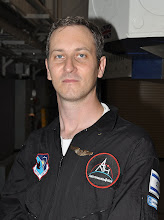1. Customer Obsession
Leaders start with the customer and work backwards. They work vigorously to earn and keep customer trust. Although leaders pay attention to competitors, they obsess over customers.
There are several kinds of customers of the space industry, from governments to companies who rely on yet other companies for parts. The ultimate customers, at least for human spaceflight, are the people riding spacecrafts. These customers so far have been tough men and women who were riding experimental spacecraft and were willing to take the rigor and risk of doing so. Since 2001, people with somewhat less "right stuff" (but a lot of money) also flew on the Soyuz as space tourists (the first being Dennis Tito), and in a few years (about 2 years away since 2004) many more with even less right stuff (and somewhat less money) will also be able to go, albeit on shorter suborbital flights, at least initially (Virgin Galactic, we're all waiting for your powered test flights!).
Unlike with Amazon products and services, which are pretty safe to use, that is not the case with manned spacecraft (getting the wrong product shipped or a Kindle malfunction can be annoying but won't kill you). Customer Obsession when your customer is an astronaut, space tourist or researcher revolves first and foremost around safety, the simple yet costly concept of not hurting (or killing) your customer. Humans, as much as they are comfortable in Earth gravity and atmosphere, need special considerations when sent to space, from adjusting a rocket flight profile to avoid tearing the rider apart during launch due to excessive G forces to taking oxygen on the ride to heat shielding to avoid cooking the human passenger; and of course also tools and controls for the capsule, shuttle or space station.
So how did the space industry so far do here? I'd say pretty good, for a test flight program. Cost is prohibitive, no mass production or any meaningful percentage of customer adoption, and for the most part, it is not much fun (if you remove the fact that you're going to frickin' space, obviously).
Why do I call it a test flight program? For a crude comparison, let's look at the Boeing 787, in many ways the first really new airplane in decades (read about it on the Boeing website). That's important as it is not yet a massively produced airplane and it uses technologies and materials not used in that scale in the past, similarly to new spacecraft. The first plane, pre-ordered by All Nippon Airways, went through 518 test flights amounting to over 1,300 hours of flight. Compare that to the space shuttle, whose first integrated test flight had astronauts in it. The most flown shuttle, Atlantis, flew 33 times, each firing the shuttle engines for 8:30 minutes, i.e. less than 5 hours total of engine flight. The accident rate of the space shuttle was 2 in 135 flights, a statistical reliability of 98.52%. Such a reliability record would have taken down the first 787 a long time ago.
Space is about to become the location of airlines such as Virgin Galactic. How many test flights will they have before a true paying customer goes on one? How much Customer Obsession will the new spaceliners and spacecraft makers exhibit?

 Space Shuttle Launch Poll Results
Space Shuttle Launch Poll Results













No comments:
Post a Comment